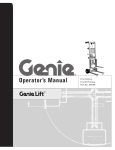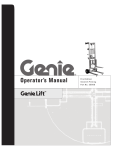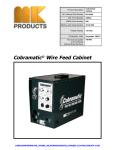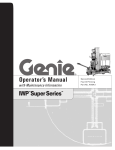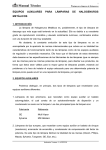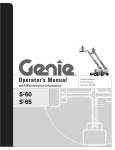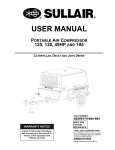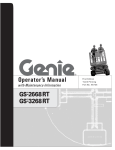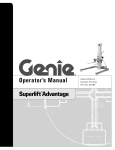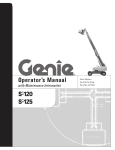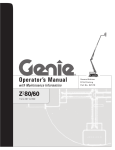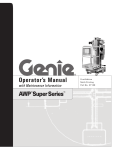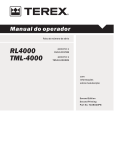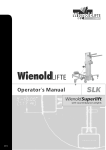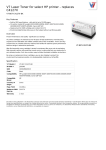Download Operator`s Manual - Genie Industries
Transcript
Operator’s Manual with Maintenance Information Second Edition Seventh Fourth Printing Printing Part No. 82199 43645 Operator's Manual Second Edition • Fourth Printing Important Read, understand and obey these safety rules and operating instructions before operating this machine. Only trained and authorized personnel shall be permitted to operate this machine. This manual should be considered a permanent part of your machine and should remain with the machine at all times. If you have any questions, call Genie Industries. Contents Page Safety ........................................................................ 1 Legend ....................................................................... 6 Controls ..................................................................... 7 Pre-operation Inspection ............................................ 8 Maintenance ............................................................. 10 Function Tests .......................................................... 13 Workplace Inspection ................................................ 16 Operating Instructions ............................................... 17 Decals ...................................................................... 20 Specifications ........................................................... 22 Reporting Safety Defects .......................................... 23 Contact us: Internet: http://www.genielift.com e-mail: [email protected] Copyright © 2000 by Genie Industries First Edition: Second Printing, March 2001 Second Edition: Fourth Printing, April 2002 "Genie" is a Registered Trademark of Genie Industries in the USA and many other countries. "TML" is a trademark of Genie Industries. Printed on recycled paper Printed in U.S.A. Genie TML-4000 & Genie TML-4000N Part No. 82199 Second Edition • Fourth Printing Operator's Manual Safety Rules Warning Failure to obey the instructions and safety rules in this manual may result in death or serious injury. Do Not Operate Unless: You learn and practice the principles of safe machine operation contained in this operator's manual. 1 Avoid hazardous situations. Know and understand the safety rules before going on to the next section. 2 Always perform a pre-operation inspection. 3 Always perform the function tests prior to use. 4 Inspect the workplace. 5 Only use the machine as it was intended. You read, understand and obey: manufacturer's instructions and safety rules–operator's manual and machine decals employer's safety rules and worksite regulations applicable governmental regulations Part No. 82199 Genie TML-4000 and TML-4000N 1 Operator's Manual Second Edition • Fourth Printing SAFETY RULES Do not adjust or stow the outriggers when the mast is raised. Fall Hazards Do not stand on the machine. Do not use the machine on a moving or mobile surface or vehicle. Do not climb on the mast. Be sure the tires are in good condition and the lug nuts are properly tightened. Tip-over Hazards Do not raise the mast to the vertical position unless all outriggers are properly deployed, the foot pads are in firm contact with the ground and the machine is level. Do not set the machine up on a surface where it cannot be leveled using only the leveling jacks. Do not use chocks, blocks or shims of any kind to level the machine. Do not hang any objects from the lights or mast. Do not use the mast to raise material or personnel. Electrocution Hazards This machine is not electrically insulated and will not provide protection from contact with or proximity to electrical current. Maintain safe distances away from electrical power lines and apparatus in accordance with applicable governmental regulations and the following chart. Voltage Phase to Phase Minimum Safe Approach Distance Feet Meters Do not move the machine unless the mast is lowered to the horizontal position and securely locked in place. 0 to 300V Avoid Contact 300V to 50KV 10 3.05 Do not extend the mast when wind speeds may exceed 60 mph / 27 m/sec. 50KV to 200KV 15 4.60 200KV to 350KV 20 6.10 350KV to 500KV 25 7.62 500KV to 750KV 35 10.67 750KV to 1000KV 45 13.72 Allow for mast movement and electrical line sway or sag, and be aware of strong or gusty winds. Do not place ladders or scaffolds against any part of the machine. Do not alter or disable machine components that in any way affect safety and stability. 2 Genie TML-4000 and TML-4000N Part No. 82199 Second Edition • Fourth Printing Operator's Manual SAFETY RULES Keep away from the machine if it contacts energized power lines. Personnel must not touch or operate the machine until power lines are shut off. Crushing Hazards Do not lower the mast unless the area below is clear of personnel and obstructions. Do not release the spring latch on the side of the machine unless the mast sections are fully retracted. Do not operate the machine during lightning or storms. Keep hands and fingers away from any potential pinch points. Do not use the machine as a ground for welding. Damaged Machine Hazards Do not connect wires directly to the generator. Connect auxiliary equipment only to the power outlets provided. Do not use a damaged or malfunctioning machine. Inspect the power cord for damage prior to each use. Replace any damaged cord before operating. Do not use a machine with a worn, frayed, kinked or damaged cable. Do not allow the power cord to become caught or crushed while raising, lowering or rotating the mast. Avoid electrical shock from contact with battery terminals. Remove all rings, watches and other jewelry. Collision Hazard Be sure the operator's manual is complete, legible and in the storage container located on the machine. Be sure all decals are legible and in place. Explosion and Fire Hazards Check the work area for overhead obstructions or other possible hazards. Do not start the engine if you smell or detect diesel fuel or other explosive substances. Bodily Injury Hazard Do not refuel the machine with the engine running. Do not grasp the cable. Refuel the machine and charge the battery only in an open, well-ventilated area away from sparks, flames and lighted tobacco. Use proper lifting techniques when lifting and positioning the tongue of the machine. Burn Hazard Do not touch the lamp fixtures while they are turned on. Turn off the lamps and allow them to cool before touching. Part No. 82199 Do not operate the machine in hazardous locations or locations where potentially flammable or explosive gases or particles may be present. Keep sparks, flames and lighted tobacco away from the battery. Batteries emit an explosive gas. Genie TML-4000 and TML-4000N 3 Operator's Manual Second Edition • Fourth Printing SAFETY RULES Component Damage Hazards Towing Hazards Do not turn the lights on unless the engine is running. Always turn the lights off before shutting down the engine. Read, understand and obey all of your tow vehicle manufacturer’s recommendations, warnings and instructions before towing this machine. Do not use any battery charger greater than 12V to charge the battery. Do not tow the machine unless the mast is lowered to the horizontal position and the mast hold-down latch is securely locked in place. Do not expose the battery or the charger to water or rain. Improper Use Hazard When leaving the machine unattended, secure from unauthorized use. Unauthorized personnel may attempt to operate the machine without proper instruction, creating an unsafe condition. Do not overload your tow vehicle. Check the manufacturer's Gross Vehicle Weight Rating (GVWR). To obtain the gross vehicle weight, add the tongue weight of the trailer to the vehicle weight (including vehicle, passengers and cargo). Do not load cargo on the machine. The TML is not designed to carry any extra cargo. Be sure the hitch is securely attached to the tow vehicle. Be sure the safety chains (if required) are securely attached to the tow vehicle. Be sure that all driving lights are operational. Be sure all hitch components, lights and mirrors and methods of attaching the trailer to the tow vehicle conform to local, state and federal regulations. Do not tow the machine on public roads unless it meets all governmental regulations for towing. Do not exceed 60 mph / 97 km/h. Obey all local and national towing speed laws. Be sure to chock the wheels of the trailer when parking on a hill. 4 Genie TML-4000 and TML-4000N Part No. 82199 Second Edition • Fourth Printing Operator's Manual SAFETY RULES Decal Legend Genie product decals use symbols, color coding and signal words to identify the following: Safety alert symbol—used to alert personnel to potential personal injury hazards. Obey all safety messages that follow this symbol to avoid possible injury or death. Red—used to indicate the presence of an imminently hazardous situation which, if not avoided, will result in death or serious injury. Orange—used to indicate the presence of a potentially hazardous situation which, if not avoided, could result in death or serious injury. Yellow with safety alert symbol— used to indicate the presence of a potentially hazardous situation which, if not avoided, may cause minor or moderate injury. Yellow without safety alert symbol—used to indicate the presence of a potentially hazardous situation which, if not avoided, may result in property damage. Green—used to indicate operation or maintenance information. Part No. 82199 Genie TML-4000 and TML-4000N 5 Operator's Manual Second Edition • Fourth Printing Legend 1 Outrigger leveling jack with footpad 2 Outrigger jack handle 3 Outrigger 4 Cover Access under this cover: Engine Generator Power outlets (Standard models) Access under opposite cover: Fuel tank Power outlets (Narrow models) Manual storage container 6 5 Mast hold-down latch 13 Tongue outrigger 6 Lamp fixtures 14 Coupler 7 Mast 15 Control panel (under cover) 8 Forklift pocket 16 Mast release latch 9 Lifting eye 17 RAISE/LOWER winch handle 10 Mast rotation lever 18 Fender 11 EXTEND/RETRACT winch handle 19 Tire 12 Front spring latch (behind mast) Genie TML-4000 and TML-4000N Part No. 82199 Second Edition • Fourth Printing Operator's Manual Controls Control Panel 1 Key switch 4 Glow plug indicator light 2 Hour meter 5 Oil pressure indicator light 3 Circuit breaker switches for lights (4) Part No. 82199 Genie TML-4000 and TML-4000N 6 Water temperature indicator light 7 Air filter condition indicator light 7 Operator's Manual Second Edition • Fourth Printing Pre-operation Inspection Fundamentals It is the responsibility of the operator to perform a Pre-operation Inspection and routine maintenance. The Pre-operation Inspection is a visual inspection performed by the operator prior to each work shift. The inspection is designed to discover if anything is apparently wrong with a machine before the operator performs the function tests. Do Not Operate Unless: You learn and practice the principles of safe machine operation contained in this operator’s manual. 1 Avoid hazardous situations. 2 Always perform a pre-operation inspection. Know and understand the pre-operation inspection before going on to the next section. 3 Always perform the function tests prior to use. 4 Inspect the workplace. 5 Only use the machine as it was intended. The Pre-operation inspection also serves to determine if routine maintenance procedures are required. Only routine maintenance items specified in this manual may be performed by the operator. Refer to the list on the next page and check each of the items and locations for modifications, damage or loose or missing parts. A damaged or modified machine must never be used. If damage or any variation from factory delivered condition is discovered, the machine must be tagged and removed from service. Repairs to the machine may only be made by a qualified service technician, according to the manufacturer's specifications. After repairs are completed, the operator must perform a pre-operation inspection again before going on to the function tests. Scheduled maintenance inspections shall be performed by qualified service technicians, according to the manufacturer's specifications. 8 Genie TML-4000 and TML-4000N Part No. 82199 Second Edition • Fourth Printing Operator's Manual PRE-OPERATION INSPECTION Pre-operation Inspection o Be sure that the operator’s manual is complete, legible and in the storage container located on the machine. Check entire machine for: o Be sure that all decals are legible and in place. See Decals section. o Dents or damage to machine o Check for engine oil leaks and proper fluid level. Add oil if needed. See Maintenance section. o Check for engine coolant leaks and proper coolant level. Add coolant if necessary. See Maintenance section. o Cracks in welds or structural components o Be sure that all structural and other critical components are present and all associated fasteners and pins are in place and properly tightened. o Be sure that the battery is in place and properly connected. o Check for battery fluid leaks and proper fluid level. Add distilled water if needed. See Maintenance section. o Check for proper tire pressure and lug nut torque. Add air to tires if needed. See Maintenance section. Check the following components or areas for damage, modifications and improperly installed or missing parts: o Electrical components, wiring and electrical cables o Mast tubes o Winches and related components o Latches and pins o Tires and wheels o Trailer lights and reflectors o Outriggers, leveling jacks and foot pads o Nuts, bolts and other fasteners o Lamp fixtures and bulbs o Cable (kinks, frays and abrasions) o Safety chains (if required) o Engine and related components o Fuel tank o Generator Part No. 82199 Genie TML-4000 and TML-4000N 9 Operator's Manual Second Edition • Fourth Printing Maintenance Check the Engine Oil Level Maintaining the proper engine oil level is essential to good engine performance and service life. Operating the machine with an improper oil level can damage engine components. Observe and Obey: Only routine maintenance items specified in this manual shall be performed by the operator. Scheduled maintenance inspections shall be completed by qualified service technicians, according to the manufacturer's specifications and the requirements specified in the responsibilities manual. Check the oil level with the engine off. 1 Check the oil level dipstick. Deutz models: Result: The oil level should be at the FULL mark on the dipstick. Add oil as needed. Perkins models: Result: The oil level should be between the two notches on the dipstick. Add oil as needed. Maintenance Symbols Legend The following symbols have been used in this manual to help communicate the intent of the instructions. When one or more of the symbols appear at the beginning of a maintenance procedure, it conveys the meaning below. Indicates that tools will be required to perform this procedure. Deutz F3M 1008 Engine Oil viscosity requirements -40° to 77°F / -40° to 25°C 5W-30 (synthetic) -25° to 86°F / -13° to 30°C 10W-40 -20° to 77°F / -4° to 25°C 15W-30 Use oils meeting API classification CC, CF or CE, as they offer improved wear protection. Perkins 103-10 Engine Oil viscosity requirements Below 32°F / 0°C Indicates that new parts will be required to perform this procedure. 0W -13° to 68°F / -25° to 20°C 5W-20 -10° to 104°F / -15° to 40°C 10W-30 -14° to 122°F / -10° to 50°C 15W-40 Above 23°F / Above -5°C 20W-50 Use oils meeting API classification CC, CD, CE, CF, CF-4 or CF-G, as they offer improved wear protection. 10 Genie TML-4000 and TML-4000N Part No. 82199 Second Edition • Fourth Printing Operator's Manual MAINTENANCE Check the Tires and Wheels Tires and wheels - Standard and Narrow models Tire size ST185/80D13 Rim size Bodily injury hazard. An overinflated tire can explode and may cause death or serious injury. Collision hazard. An excessively worn tire can cause poor handling and continued use could result in tire failure. Lug nut torque Tire pressure (cold) 13 x 4.5 in 33 x 11.4 cm 80 ft-lbs 108 Nm 50 psi 3.4 bar Check the Engine Coolant Level Tip-over hazard. Do not use temporary flat tire repair products. Maintaining the tires and wheels in good condition is essential to safe operation and good performance. Tire and/or wheel failure could result in a machine tip-over. Component damage may also result if problems are not discovered and repaired in a timely fashion. 1 Check the tire surface and sidewalls for cuts, cracks, punctures and uneven or excessive tread wear. Replace the tire if uneven or excessive tread wear is found Maintaining the engine coolant at the proper level is essential to engine service life. Improper coolant level will affect the engine's cooling capability and damage engine components. Daily checks will allow the inspector to identify changes in coolant level that might indicate cooling system problems. 1 Remove the radiator cap and check the coolant level. Add fluid as needed. Result: The fluid level should be full. 2 Check each wheel for damage, bends and cracks. Replace the wheel if any damage is found. Tires and wheels must be replaced with tires and wheels of the specifications listed. Bodily injury hazard. Fluids in the radiator are under pressure and extremely hot. Use caution when removing cap and adding fluids. 3 Check each tire with an air pressure gauge and add air as needed. 4 Check the torque of each lug nut. Part No. 82199 Genie TML-4000 and TML-4000N 11 Operator's Manual Second Edition • Fourth Printing MAINTENANCE Check the Battery Scheduled Maintenance Proper battery condition is essential to good engine performance and operational safety. Improper fluid levels or damaged cables and connections can result in engine component damage and hazardous conditions. This procedure does not need to be performed on machines with sealed or maintenance-free batteries. Maintenance performed quarterly, annually and every two years must be completed by a person trained and qualified to perform maintenance on this machine according to the procedures found in the service manual for this machine. Machines that have been out of service for more than three months must receive the quarterly inspection before they are put back into service. Electrocution hazard. Contact with hot or live circuits could result in death or serious injury. Remove all rings, watches and other jewelry. Bodily injury hazard. Batteries contain acid. Avoid spilling or contacting battery acid. Neutralize battery acid spills with baking soda and water. 1 Put on protective clothing and eye wear. 2 Be sure the battery cable connections are tight and free of corrosion. 3 Remove the battery vent caps. 4 Check the battery acid level. If needed, replenish with distilled water to the bottom of the battery fill tube. Do not overfill. 5 Install the vent caps. 12 Genie TML-4000 and TML-4000N Part No. 82199 Second Edition • Fourth Printing Operator's Manual Function Tests Fundamentals The Function Tests are designed to discover any malfunctions before the machine is put into service. The operator must follow the step-by-step instructions to test all machine functions. Do Not Operate Unless: You learn and practice the principles of safe machine operation contained in this operator's manual. 1 Avoid hazardous situations. 2 Always perform a pre-operation inspection. 3 Always perform function tests prior to use. Know and understand the function tests before going on to the next section. 4 Inspect the workplace. A malfunctioning machine must never be used. If malfunctions are discovered, the machine must be tagged and removed from service. Repairs to the machine may only be made by a qualified service technician, according to the manufacturer's specifications. After repairs are completed, the operator must perform a pre-operation inspection and function tests again before putting the machine into service. Symbols Legend Indicates that a specific result is expected after performing a series of steps. 5 Only use the machine as it was intended. Part No. 82199 Genie TML-4000 and TML-4000N 13 Operator's Manual Second Edition • Fourth Printing FUNCTION TESTS Setup Test the Machine Functions 1 Position the machine at the desired work site. By raising and extending, then retracting and lowering the mast back to the horizontal position, the following functions will be tested: winches, latches, mast extension and mast rotation. 2 Disconnect the trailer lights and safety chains. 3 Open the latch on the coupler. 4 Pull the release pin on the tongue outrigger and rotate the outrigger towards the ground until the outrigger pin locks securely in place. 5 Turn the jack handle to lower the outrigger foot pad and raise the tongue of the machine enough to clear the tow vehicle. 12 Unlock the mast hold-down latch. 13 Turn the RAISE/LOWER winch handle clockwise until the mast raises approximately 2 feet / 61 cm. Result: A clicking sound should be heard as the winch handle is turned. 6 Release the spring pin on the side outriggers and lower them to the ground. Make sure the locking arms are locked in place. 14 Release the winch handle. 7 Turn the outrigger jack handles to level the machine. Level the machine using only the leveling jacks. Do not use chocks, blocks or shims to level the machine. 15 Continue to turn the winch handle clockwise until the mast reaches full vertical position. Install the Lamp Fixtures (if applicable) For each lamp fixture: 8 Remove the lamp fixture from the storage location under the covers. 9 Slide the fixture into the holes on the mounting bracket and close the latches. 10 Insert and close the safety pins. 11 Remove the cap from the receptacle socket and connect the electrical plug. Note: Make sure the safety pins are properly installed before raising the mast. 14 Result: The winch brake should hold when the handle is released. Result: The mast should raise smoothly, free of hesitation or binding. Result: The spring latch on the front of the machine should lock the mast securely into place. 16 Turn the EXTEND/RETRACT winch handle clockwise until the mast extends approximately 2 feet / 61 cm. Result: A clicking sound should be heard as the winch handle is turned. Result: The mast sections should telescope smoothly, free of hesitation or binding. 17 Release the winch handle. Result: The winch brake should hold when the handle is released. Genie TML-4000 and TML-4000N Part No. 82199 Second Edition • Fourth Printing Operator's Manual FUNCTION TESTS 18 Press and hold the mast rotation lever. Test the Lights 19 Rotate the mast clockwise and then counterclockwise as far as it will go in either direction. 27 Make sure the circuit breaker light switches are in the OFF position. Result: The mast should rotate smoothly and easily in both directions. 20 Rotate the mast back to its original position. Line up the black arrows on the front of the mast. 21 Release the mast rotation lever 22 Attempt to rotate the mast in both directions. Result: The mast should not rotate. 23 Turn the EXTEND/RETRACT winch handle counterclockwise until the mast sections are fully retracted. Line up the blue arrows on the side of the mast. 28 Start the engine. See Starting the Engine in the Operating Instructions section. 29 Turn all four circuit breaker light switches to the ON position. Result: The lights should come on. Note: It can take up to 20 minutes for the lights to reach full intensity. If the lights are turned off and turned back on while they are still warm, they will not light up again for 20-30 minutes. Note: Make sure the circuit breaker light switches are turned off before shutting down the engine. Result: No clicking sound should be heard when the winch handle is turned. 24 Pull and hold the mast release latch below the control panel. 25 Begin lowering the mast to the horizontal position by turning the RAISE/LOWER winch handle counterclockwise and holding the release latch open. Result: No clicking sound should be heard when the winch handle is turned. 26 Release the mast release latch and continue to crank the winch handle counterclockwise until the mast reaches horizontal position. Note: Make sure the mast is lowered completely into the transport cradle. Follow the mast stowing instructions in the Operating Instructions section to make sure the mast hold-down latch is securely locked. Part No. 82199 Genie TML-4000 and TML-4000N 15 Operator's Manual Second Edition • Fourth Printing Workplace Inspection Be aware of and avoid the following hazardous situations: · Drop-offs or holes · Bumps and obstructions · Debris Do Not Operate Unless: · Overhead obstructions and high voltage conductors You learn and practice the principles of safe machine operation contained in this operator's manual. 1 Avoid hazardous situations. 2 Always perform a pre-operation inspection. 3 Always perform function tests prior to use. · Hazardous locations · Inadequate surface support to withstand all load forces imposed by the machine · Wind and weather conditions · The presence of unauthorized personnel · All other possible unsafe conditions 4 Inspect the workplace. Know and understand the workplace inspection before going on to the next section. 5 Only use the machine as it was intended. Fundamentals The Workplace Inspection helps the operator determine if the workplace is suitable for safe machine operation. It should be performed by the operator prior to moving the machine to the workplace. It is the operator's responsibility to read and remember the workplace hazards, then watch for and avoid them while moving, setting up and operating the machine. 16 Genie TML-4000 and TML-4000N Part No. 82199 Second Edition • Fourth Printing Operator's Manual Operating Instructions Setup Make sure the machine is set up according to the Setup procedure in the Function Tests section. Starting the Engine Do Not Operate Unless: 1 Make sure the circuit breaker light switches are in the OFF position. You learn and practice the principles of safe machine operation contained in this operator's manual. 1 Avoid hazardous situations. 2 Always perform a pre-operation inspection. 3 Always perform function tests prior to use. 4 Inspect the workplace. 5 Only use the machine as it was intended. 2 Turn the key OR turn the switch to the RUN position. The glow plug light will come on. 3 Wait for the glow plug light to go off. 4 To start the engine, turn the key OR turn the switch to START. Operation of Lights 1 Turn on the lights using the circuit breaker switches located on the control panel. Each switch corresponds to one of the lamps. Note: The lights can take up to 20 minutes to reach full intensity. Note: If the lights are turned off and turned back on while they are still warm, they will not light up again for 20-30 minutes. Fundamentals The Operating Instructions section provides instructions for each aspect of machine operation. It is the operator's responsibility to follow all the safety rules and instructions in the operator's, safety and responsibilities manuals. 2 Turn the lights off by turning the circuit breaker switches to the OFF position. Make sure the lights are turned off before shutting down the engine. If more than one operator is expected to use a machine at different times in the same work shift, each operator is expected to follow all safety rules and instructions in the operator's manual. That means every new operator should perform a preoperation inspection, function tests and a work place inspection before using the machine. Part No. 82199 Genie TML-4000 and TML-4000N 17 Operator's Manual Second Edition • Fourth Printing OPERATING INSTRUCTIONS 4 Turn the RAISE/LOWER winch handle counterclockwise and lower the mast completely into the transport cradle. To Raise the Mast 1 Unlock the mast hold-down latch. 2 Turn the RAISE/LOWER winch handle clockwise until the mast reaches the full vertical position and the front spring latch locks the mast firmly in place. Note: If the mast has not been fully retracted, it will not rest completely in the cradle. To Extend the Mast 3 Turn the latch handle clockwise until the handle points straight down. The latch should turn freely without binding or hesitation. 1 Turn the EXTEND/RETRACT winch handle clockwise to extend the mast sections. 2 Approximately 6 inches below full mast extension, the lamp fixture will begin to tilt. The more the winch handle is turned, the greater the tilt, until the mast is fully extended and the lights are positioned. Note: To adjust the lights after the mast is fully extended, slowly lower the mast by turning the winch handle counterclockwise until the lights are in the desired position. To Rotate the Mast 1 Press and hold the mast rotation lever and rotate the mast to the desired position. 2 Turn the mast hold-down latch handle counterclockwise and push into the lock. After Each Use 1 Select a safe parking location—firm, level surface, clear of obstructions and traffic. 2 Remove the key OR lock the conrol panel to secure from unauthorized use. To Store the Lamp Fixtures (Standard models) Note: Do not touch hot lamp fixtures. Make sure the lights are turned off and the lamp fixtures have cooled down before touching. For each lamp fixture: 2 Release the lever. 1 Disconnect the electrical plug and cap the receptacle socket. To Stow the Mast 1 Press and hold the mast rotation lever and rotate the mast to its original position. Line up the black arrows on the front of the mast. 2 Turn the EXTEND/RETRACT winch handle counterclockwise until the mast sections retract. The mast is fully retracted when the blue arrows on the side of the mast are lined up. 2 Remove the safety pins and release the latches. 3 Pull the lamp fixture up and off the mounting bracket. 3 Slide the lamp fixture onto the channels located under the covers. 4 Close and secure the covers before transport. 3 Pull and hold the mast release latch below the control panel. 18 Genie TML-4000 and TML-4000N Part No. 82199 Second Edition • Fourth Printing Operator's Manual OPERATING INSTRUCTIONS Transport 1 Make sure the mast hold-down latch is securely locked in place. 2 Make sure the covers are closed and secured. 3 Push to release the lock handle on each of the side outriggers and place in the stowed position. Make sure the spring pins lock the outriggers securely in place. 4 Raise the tongue of the machine by turning the tongue outrigger jack handle. 5 Position the transport vehicle under the coupler on the tongue of the machine. 6 Open the latch on the coupler. 7 Turn the tongue outrigger jack handle to lower the tongue and raise the outrigger foot pad off the ground. 8 Close the latch on the coupler. 9 Rotate the tongue outrigger to the stowed position and secure with the lock pin. 10 Attach the safety chains (if required). 11 Connect and test the trailer lights. Increase the distance between your vehicle and the vehicle in front of you to twice the normal following distance when towing a trailer. Allow more following distance in adverse weather. Slow down for downgrades and shift your transmission into a lower gear. Slow down for curves, hazardous road conditions, freeway exits, and when driving in adverse weather. Heavy winds, excessive speed, load shifting or passing vehicles can cause the trailer to sway while driving. If this occurs, do not brake, speed up or turn the steering wheel. Turning the steering wheel or applying the brakes can cause the vehicle and trailer to jackknife. Let up on the gas pedal and keep the steering wheel straight. If the vehicle and/or trailer travels off the paved road, hold the steering wheel firmly and let up on the gas pedal. Do not apply the brakes. Do not turn sharply. Slow down to under 25 mph / 40 km/h. Gradually turn the steering wheel to get back on the road. Proceed with caution when entering traffic. When passing other vehicles, be sure to leave enough room for the extra length of the trailer. You will need to go much farther beyond the passed vehicle before you can return to your lane. Towing Information Avoid jerky or sudden movements when turning. Use the checklist provided on the back cover of this manual before towing and while on the road. Transport (not attached to a tow vehicle) Inspect all connections at each stop. Driving a vehicle/trailer combination is different from driving a vehicle alone. All tires must be properly inflated. Find the recommended cold tire pressures on the tire sidewall or trailer decal. Do not overinflate the tires. Tire pressures go up during driving. Checking the tire pressure when the tires are warm will give you an inaccurate pressure reading. Part No. 82199 Make sure the mast is fully lowered to the horizontal position and the mast hold-down latch is securely locked in place before lifting the TML with a forklift or crane. Genie TML-4000 and TML-4000N 19 Operator's Manual Second Edition • Fourth Printing Decals Decal Inspection Use the pictures on the next page to verify that all decals are legible and in place. Below is a numerical list with quantities and descriptions. Part No. Description Quantity Part No. Description Quantity 28159 Label - Diesel 1 72077 Label - Black Arrow 2 28161 Warning - Crush Hand 4 72826 Label - Extend/Retract Winch 1 28164 Notice - Hazardous Materials 2 72828 Notice - Tire Specifications 2 28171 Label - No Smoking 1 72865 Control Panel 1 31072 Manual Storage Container 1 72870 Caution - Component Contact 2 52475 Label - Transport Tie-down 2 72871 Label - Power Outlet, 120V 1 62707 Warning - Tow Speed 1 72874 Label - Locked, Unlocked 1 65408 Notice - Operating Instructions 1 72889 Warning - Transport Hazard 1 65409 Notice - Mast Rotation Instructions 1 72890 Notice - Mast Retraction 1 65411 Warning - General Safety 1 72891 Label - Blue Arrow 2 65412 Warning - Transport Instructions 1 82219 Label - Power Outlets 1 65414 Danger - Electrocution Hazard 2 82222 65421 Warning - Electrocution, Generator 2 Caution - Light Storage, Standard Models 2 65423 Notice - Engine specs, Deutz 1 82223 Label - Light Storage, Standard Models 4 72008 Caution - Turn Off Lights 1 82224 Label - HOT 8 72009 Cosmetic - Genie TML-4000 2 82237 Danger - High Voltage 1 72010 Cosmetic - Genie TML-4000N 2 82302 Notice - Engine Spec, Perkins 1 72018 Label - Raise/Lower Winch 1 82303 Label - Mast Release Latch 1 72019 Danger - High Voltage 1 82304 Control Panel 1 20 Genie TML-4000 and TML-4000N Part No. 82199 Second Edition • Fourth Printing Operator's Manual DECALS Control Panel Side Shading indicates decal is hidden from view, i.e. under covers Fuel Tank Side Part No. 82199 Genie TML-4000 and TML-4000N 21 Operator's Manual Second Edition • Fourth Printing Specifications Model - TML-4000 Standard Model - TML-4000 Narrow Height, stowed 71 in 1.8 m Height, stowed 71 in 1.8 m Length, stowed 14 ft 7 in 4.4 m Length, stowed 14 ft 7 in 4.4 m Width, stowed 70 in 1.8 m Width, stowed 55 in 1.4 m Extended tower height 28 ft 8.5 m Extended tower height 28 ft 8.5 m Weight See Serial Plate (Machine weights vary with option configurations) Weight See Serial Plate (Machine weights vary with option configurations) Maximum tongue weight Maximum tongue weight 145 lbs 66 kg Tire size Engine type ST185/80D13 3 cylinder diesel, water cooled Deutz F3M1008 OR Perkins 103-10 Fuel capacity 50 gallons 189 liters Generator 6 kw Total lighting wattage Replacment bulbs 4000 watts 1000 W Metalarc M47 R M1000/U/BT37 or equivalent Run time (full load with full fuel tank) Tower rotation Maximum towing speed Maximum wind speed rating 100 hours 360 degrees, non-continuous 60 mph 97 km/h 60 mph 27 m/sec Airborne Noise Emissions 71 dB Maximum sound level at normal operating workstations (A-weighted) 110 lbs 50 kg Tire size Engine type ST185/80D13 3 cylinder diesel, water cooled Deutz F3M1008 OR Perkins 103-10 Fuel capacity 30 gallons 114 liters Generator 6 kw Total lighting wattage Replacment bulbs 4000 watts 1000 W Metalarc M47 R M1000/U/BT37 or equivalent Run time (full load with full fuel tank) Tower rotation Maximum towing speed Maximum wind speed rating 60 hours 360 degrees, non-continuous 60 mph 97 km/h 60 mph 27 m/sec Airborne Noise Emissions 71 dB Maximum sound level at normal operating workstations (A-weighted) Continuous improvement of our products is a Genie policy. Product specifications are subject to change without notice or obligation. 22 Genie TML-4000 and TML-4000N Part No. 82199 Second Edition • Fourth Printing Operator's Manual Reporting Safety Defects Genie Industries PO Box 97030 Redmond, WA 98073-9730 Reporting Safety Defects If you believe that your vehicle has a defect which could cause a crash or could cause injury or death, you should immediately inform the National Highway Traffic Safety Administration (NHTSA) in addition to Genie Industries. If NHTSA receives similar complaints, it may open an investigation, and if it finds that a safety defect exists in a group of vehicles, it may order a recall and remedy campaign. However, NHTSA cannot become involved in any individual problems between you, your dealer or Genie Industries. To contact NHTSA you may either call the Auto Safety Hotline toll-free at 1-800-424-9393 (3660123 in Washington DC area) or write to: NHTSA U.S. Department of Transportation 400 7th Street SW, (NSA-11) Washington DC 20590 You can also obtain information about motor vehicle safety from the Hotline. Part No. 82199 Genie TML-4000 and TML-4000N 23 Towing Checklist Hitching · · · · · Hitch is sufficient to tow trailer and load Hitch is properly attached to tow vehicle Safety chains (if required) are properly attached All tires have correct pressure All lights are connected and working Towing · · · · Genie North America Phone Toll Free 425.881.1800 USA and Canada 800.536.1800 Fax 425.883.3475 Do not exceed 60 mph / 97 km/h Check connections and tire pressure at each stop Slow down for hazardous conditions Allow extra distance for following and passing other vehicles Genie Australia Pty Ltd. Phone Fax 1 61 7 3375 1660 1 61 7 3375 1002 California Proposition 65 Genie China Phone Fax 86 21 53852570 86 21 53852569 WARNING Genie Malaysia Phone Fax 604 228 1235 604 226 6872 Genie Japan Phone Fax 81 3 3453 6082 The exhaust from this product contains chemicals 81 3 3453 6083 known to the State of California to cause cancer, Genie Korea Phone Fax 82 2 558 7267 birth defects or other reproductive harm. 82 2 558 3910 Genie Africa Phone Fax 27 11 455 0373 27 11 455 0355 Genie Latin America Phone Fax 55 11 4055 2499 55 11 4043 1661 Genie Holland 31 70 51 78836 31 70 51 13993 Genie Denmark Phone Fax 45 6612 5544 45 6612 5530 Genie France Phone Fax 33 2 37 26 09 99 33 2 37 26 09 985 Genie Spain Phone Fax 34 93 579 5042 34 93 579 5059 Genie Germany Phone Fax 49 4202 8852-0 49 4202 8852-20 Genie U.K. Phone Fax 44 1476 584333 44 1476 584334 Genie Mexico City Phone Fax 52 5 653 03 84 52 5 664 40 16 Distributed By: Phone Fax


























